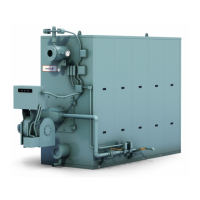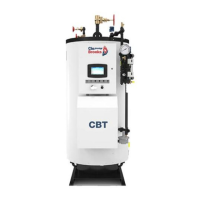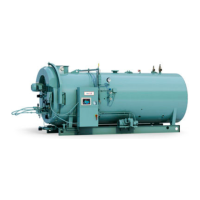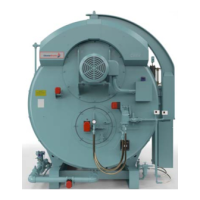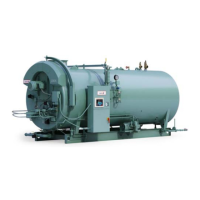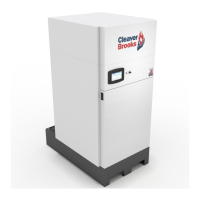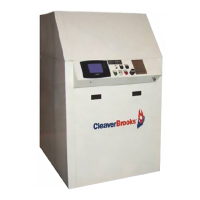Adjustment Procedures Chapter 5
750-177 5-3
The Operating Limit Control senses temperature or pressure and automatically turns the burner on to initiate
the start-up sequence when required and turns the burner off to initiate the shutdown sequence when the
demand is satisfied. The control must be set to initiate startup only at the low fire position.
The
Modulating Control senses changes in the hot water temperature or steam pressure and signals the
modulating motor to control the flow of fuel and air to the burner. With either steam or hot water boilers, the
modulating control must be set to ensure the burner is at its minimum low fire position before the operating
limit control either starts or stops the burner.
When adjusting or setting controls, first be sure all contr
ol devices are securely mounted and level. With the
temperature sensing control, make sure the sensing bulb is properly bottomed in its well and is secured against
movement. Be sure the connecting tubing is not kinked.
The dial settings are generally accurate; although it is no
t unusual to have a slight variation between a scale
setting and an actual pressure gauge or thermometer reading. Always adjust control setting to agree with
pressure gauge or thermometer readings. Accurate instrument readings are required. When necessary use
auxiliary test equipment to set controls.
Burner controls correctly set to ma
tch load demands will provide operational advantages and achieve the
following desirable objectives:
• The burner will be operating in low fire position prior to shut down.
• The burner will operate at low fire for a brief
period on each start during normal operation.
• Eliminates frequent burner on-off cycling.
Separate and independent controls affect modulated firing and burner on-off cycling. Figure 5-3 depicts a
typical setting relationship of the
operating limit control, modulating control and the high limit control.
The burner will be “on” whenever the pressure or
temperature is less than point B and “off” whenever
pressure or temperature is greater than point A. The distance between points A and B represents the “on-off”
differential of the
operating limit control.
In normal operation, the burner will shut down whenever the
pressure or temperature rises above setting A.
At that point the switch in the
operating limit control will open. As the pressure or temperature drops back to
B, the
operating limit control closes and the burner will restart. The modulating control will signal the
modulating motor to be in a low fire position. If the load demands exceed the low fire input potential, the
modulating control will increase the firing rate proportionately as pressure or temperature falls toward point
D. The modulating motor will stop at any intermediate point between C and D whenever the fuel input
balances the load requirement.
As the load requirement changes, the firing rate will chan
ge accordingly. Thus it is referred to as modulated
firing.
Point D represents the maximum firing rate of the burner
, or highfire. In the event pressure or temperature
drops while the burner is firing at highfire, it indicates that the load exceeds the capacity of the boiler.
The firing graph (Figure 5-1) shows that point B and
point C do not coincide. Extreme load conditions could
require the points be closely matched.
When set as shown, with a time lag between B and
C, the burner will be in a low fire position upon a restart
and will fire at that rate for a short period of time before falling pressure or temperature requires an increase
in the firing rate.
Excessive cycling increases the potential and severity of internal condensation. On-Off cycling
should be limited to eight (8) cycles or less per hour to keep the blower motor from overheating and
excessive wear on the switch gear and pilot. Failure to follow these instructions could result in dam
-
age and premature failure of the equipment.
A
B
